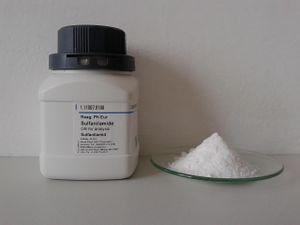Sulfanilamide
From Sciencemadness Wiki
Revision as of 21:02, 1 December 2016 by Mabus (Talk | contribs) (Created page with "{{Chembox | Name = Sulfanilamide | Reference = | IUPACName = 4-Aminobenzenesulfonamide | PIN = | SystematicName = 4-Aminobenzenesulfonamide | OtherNames = Sulfamine<br>Sulphan...")
 Sulfanilamide sample and original bottle
| |
| Names | |
|---|---|
| IUPAC name
4-Aminobenzenesulfonamide
| |
| Systematic IUPAC name
4-Aminobenzenesulfonamide | |
| Other names
Sulfamine
Sulphanilamide Sulphonamide | |
| Properties | |
| C6H8N2O2S | |
| Molar mass | 172.20 g/mol |
| Appearance | White solid |
| Density | 1.08 g/cm3 |
| Melting point | 165 °C (329 °F; 438 K) |
| 0.75 g/100 ml (25 °C) 47.7 g/100 ml (100 °C)[1] | |
| Solubility | Soluble in aq. alkali, ethanol, glycerol, hydrochloric acid, propylene glycol Insoluble in benzene, chloroform, diethyl ether, petroleum ether |
| Solubility in acetone | 20 g/100 ml |
| Solubility in ethanol | 2.7 g/100 ml |
| Vapor pressure | ~0 mmHg |
| Acidity (pKa) | 10.6 |
| Hazards | |
| Safety data sheet | Sigma-Aldrich |
| Except where otherwise noted, data are given for materials in their standard state (at 25 °C [77 °F], 100 kPa). | |
| Infobox references | |
Sulfanilamide is a sulfonamide antibacterial, one of the earliest, now largely replaced by more powerful antibiotics. It also has some uses in analytical chemistry.
Contents
Properties
Chemical
Physical
Sulfanilamide is a white solid, soluble in hot water and organic solvents.
Availability
Can be purchased online.
Preparation
Sulfanilamide can be made from benzene through a series of stages, as seen here.
Projects
- Make antibiotic
Handling
Safety
Sulfanilamide is a strong antibacterial agent, though lab grade is not safe to consume.
Storage
As it is sensitive to light, it should be kept in amber bottles, in dark places.
Disposal
Can be dumped down the drain or in the trash, in small quantities.
References
- ↑ Budavari, S. (ed.). The Merck Index - Encyclopedia of Chemicals, Drugs and Biologicals. Rahway, NJ: Merck and Co., Inc., 1989., p. 1409